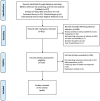Use of gonadotropin-releasing hormone agonists in transgender and gender diverse youth: a systematic review
- PMID: 40438403
- PMCID: PMC12116301
- DOI: 10.3389/fendo.2025.1555186
Use of gonadotropin-releasing hormone agonists in transgender and gender diverse youth: a systematic review
Abstract
Introduction: Puberty suppression using gonadotropin-releasing hormone agonists (GnRHa) is a reversible medical intervention that halts endogenous puberty, allowing transgender and gender-diverse (TGD) adolescents to avoid the development of secondary sexual characteristics that may cause psychological distress. This pause in pubertal progression provides time to explore gender identity or facilitates alignment with affirmed gender in those with an established identity. While widely used, long-term evidence on the efficacy and safety of GnRHa in this population remains limited. This systematic review aims to synthesize current data on the benefits and potential risks of GnRHa in TGD adolescents.
Methods: We conducted a comprehensive literature search across PubMed, EMBASE, Cochrane Library, and other databases, covering studies published from February 2011 to February 2024. Eligible studies included adolescents under 18 with gender dysphoria or incongruence treated with GnRHa, reporting outcomes related to efficacy or side effects. Fifty-one studies met inclusion criteria, and data on physical health, mental health, bone density, fertility, and adverse events were extracted and assessed using the GRADE approach.
Results: Of the 51 studies, 22 were rated as moderate to high-quality evidence. GnRHa effectively suppressed puberty and secondary sex characteristics. Effects on growth and body composition varied; bone mineral density declined during treatment, particularly in AMAB individuals. Mental health improved significantly, including reduced depression, anxiety, and suicidality-especially when GnRHa was followed by gender-affirming hormone therapy (GAHT). Quality of life improved over time, while body dissatisfaction often persisted during suppression and improved after GAHT or surgery. No moderate- or high-quality evidence was found on fertility, sexual function, or cancer risk.
Conclusion: GnRHa is effective in halting puberty and improving mental health in TGD adolescents. However, key clinical and ethical considerations-such as bone health monitoring, fertility counseling, psychological support, and informed decision-making-must guide treatment. Long-term safety remains uncertain, particularly regarding skeletal health, reproductive outcomes and cancer risk. A precision medicine approach and co-produced longitudinal studies are essential to support safe, individualized care.
Systematic review registration: https://www.crd.york.ac.uk, identifier CRD42024528334.
Keywords: GnRH analog (GnRHa); LHRH analog; adolescence; gender dysphoria (GD); gender incongruence; transgender and gender diverse (TGD); transgender and gender diverse youth.
Copyright © 2025 Tornese, Di Mase, Munarin, Ciancia, Santamaria, Fava, Candela, Capalbo, Ungaro, Improda, Diana, Matarazzo, Guazzarotti, Toschetti, Sambati, Tamaro, Bresciani, Licenziati, Street, Aversa, Delvecchio, Faienza, Iughetti, Calcaterra, de Sanctis, Salerno and Franceschi.
Conflict of interest statement
The authors declare that the research was conducted in the absence of any commercial or financial relationships that could be construed as a potential conflict of interest. The author(s) declared that they were an editorial board member of Frontiers, at the time of submission. This had no impact on the peer review process and the final decision.
References
-
- World Health Organization . International classification of diseases for mortality and morbidity statistics (11th revision) Geneva: World Health Organization. (2019).
-
- American Psychiatric Association . Diagnostic and statistical manual of mental disorders: DSM-5. 5 ed. Washington, DC: American Psychiatric Publishing; (2013).
Publication types
MeSH terms
Substances
LinkOut - more resources
Full Text Sources
Medical
Miscellaneous


